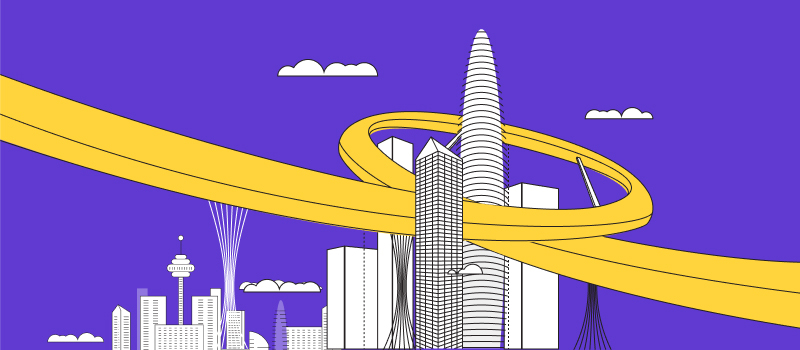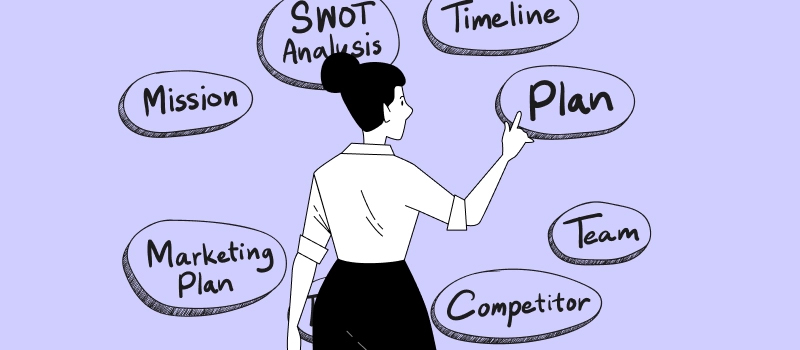
Advancements in technology, new global regulations, and an ever-changing consumer landscape mean the architecture industry is constantly evolving, and 2025 will be no different.
To help you stay ahead of the game, we thought it would be a good idea to share some of the top architecture trends brewing on the horizon for the next year. We’ll take a deep dive into topics like emerging technologies, sustainability practices, and innovative construction processes.
Get ready to buckle up – 2025 looks to be quite exciting for the architecture profession! 👀
🖨️ 3D printed architecture
3D printed architecture is the wave of the future! This cutting-edge technology takes traditional building methods to the next level, utilizing automated processes and specialized hardware to create amazingly intricate structures that can go into the construction of all sorts of buildings: from single family homes to commercial spaces and even skyscrapers.
Not only do 3D printed edifices reduce waste and increase efficiency, they can also introduce imaginative design elements, like custom curves and shapes that would be difficult to craft by hand.
Sure, it may sound a bit too futuristic now, but soon enough 3D printed architecture will become a commonplace way of constructing dwellings worthy of the digital age – and that’s what makes it one of the biggest trends for 2025.
🌱 Green architecture
“The biggest trend in the architecture industry is environmentally sustainable design, and more specifically and recently, environmentally resilient design. This trend is unique in that it has no actual visible style, but instead increases the energy performance of buildings, the life cycle of the materials used, etc. However, in the age of financial hardship and environmental decline, it only makes sense to replace stylistic trends with more mindful choices.” – Sebastian Fathi, self-employed architectural designer and the founder of Architecture Prep.
Green architecture has been all the rage since 2020’s as more and more people become aware of the need to reduce their carbon footprint and make a positive impact on the planet.
But what is green architecture about?
It’s an approach to design and construction that puts environmental sustainability at its core and takes into account resource conservation, waste reduction, and renewable energy. In other words, green architecture gives traditional building designs and materials an eco-friendly spin – structures are built with energy efficiency and human health in mind + everything from solar panels to natural sunlight and biophilic designs is employed in green architecture in order to minimize one’s environmental footprint while taking the comforts of modern living to the next level.
Considering an ever-growing understanding of the global impacts of climate change, it’s no surprise that green architecture has gone from a niche interest to an everyday lifestyle choice for people all over the world. And that’s the trend no success-oriented architect can ignore.
🤏 Tiny houses
Packing a huge style punch in an increasingly space-starved world is no small feat, but tiny houses manage to defy expectations with their incredible efficiency and adorable aesthetic. These pint-sized abodes offer all the flavor of a big house in an itsy-bitsy form along with unlimited coziness tucked into a little amount of space that no one would believe possible.
By being small and compact, tiny houses offer their dwellers an affordable – yet still highly satisfying – lifestyle. Besides, they require less resources and energy to operate, which makes them more eco-friendly than larger buildings.
🤖 New technology
Modern technology has revolutionized the architecture industry in many ways. From 3D modeling software to virtual presentations, architects have never had more freedom and versatility in their designs.
For example, VR has enabled architects to make virtual models that are interactive and lifelike. This allows them to explore designs in detail without having to build them out physically. Thanks to VR, architects can also create virtual fly-throughs that give potential clients a realistic tour of the structure’s design. And as for AR, it lets them view designs in the context of their surroundings and get a better understanding of how their structures will look and feel when placed in the real environment.
In sum, with disruptive tech forming such a powerful bond between architecture and reality, it’s ushering us into an era where innovation is king – and it’s better to embrace this trend today than feel like falling behind tomorrow.
♻️ Adaptive reuse
“In the race for new development it’s easy to forget the rich architectural history of our cities or overlook the buildings that have been around long before we built today’s ‘Concrete Jungle’. The pressure is on society to use resources much more sparingly and to develop sustainably. That means we can no longer assume that buildings have a single life span attached to their original purpose, or that once it’s over, they become redundant.” – Nicola Harwood, Senior Project Manager at CBRE.
Adaptive reuse is all about breathing new life into an old building, transforming it from its traditional use into a modern use. This includes upgrading a dilapidated warehouse building into residential lofts or converting a school into an office space.
Adaptive reuse is not only trendy, but it can also reduce waste by keeping buildings from being demolished. Moreover, it helps to bridge history with the future and make sure unique buildings and culturally significant spaces are carefully considered and maintained.
Architecturally speaking, adaptive reuse is exciting because it offers a brand-new way of looking at old buildings – not just removing them after they stopped serving their initial purpose but rather endowing them with new ones.
Who knew that giving old buildings a second chance could be so cool?
🏗️ Modular construction
Modular construction has become quite a popular fad in the architecture industry these days and for obvious reasons – it’s an efficient, cost-effective, and sustainable method of creating buildings with minimal waste.
Modular construction is essentially the process of pre-fabricating building components in a factory environment and then shipping these sections to the project site before assembling them like big blocks into the desired shape and size. This type of construction also cuts down on site preparation time since everything can be made up beforehand in an indoor setting.
So, no more rain delays!
Plus, modular construction offers a great variety of design options: from simple industrial-styled cubes to sleek, contemporary-looking skyscrapers. Indeed, it’s a fun and innovative technology for every architect to try.
🧠 Smart materials
“If we peek into the benefits that the smart materials contribute to society, we see their self-diagnostic ability to resist extreme environmental hazards and heal themselves. Their life-cycle cost efficiency helps in efficient installation and construction methods. Their benefit is not restricted to physical and mechanical features only but expands further into the domain of aesthetics.” – Syeda Neha Zaidi, Architectural Journalist at Rethinking the Future.
Such smart materials as paper-thin solar cells, hydro ceramics, and innovative biobased substances are entering the picture and changing the face of building design as we know it.
Through clever combinations of robust yet lightweight materials, architects have begun to blur the boundaries between structure and environment like never before. From homes powered by sustainable energy sources to skyscrapers made from non-toxic compounds with multiple functionalities, there are now endless possibilities for refashioning urban skylines all around the world.
We are only just beginning to scratch the surface of what is possible with a smart material approach, so who knows what revolutionizing designs may be possible in the not-too-distant future!
❤️ Community-centered design
If there’s one thing architects have learned in the last couple of decades, it’s that buildings should be designed with the community in mind.
Community-centered design offers modern architecture an extra level of the soul it would otherwise lack. It is the practice of incorporating the values, vision, and identity of local communities into the construction of versatile structures and spaces. This way, it aims to increase satisfaction for all the people involved, encourage positive interaction with the built environment, and ensure it’s tailored to the unique objectives of the city or neighborhood.
Community-centered design has become increasingly popular these days, especially among those architects who prioritize social connection and functionality over aesthetic beauty. After all, if a building doesn’t invite activities that stimulate interpersonal relationships and sound social development, what good is it?
🌈 Maximalism in interior design
The year 2025 promises to be filled with jaw-dropping interior design ideas and experiences because it’s all about maximalism.
To get in on this trend of layer upon layer of style, one needs to think bold colors, patterns, textures, fabrics, and shapes. In other words, there is no shortage of personality in maximalism because it’s fearless in its use of art, sculpture, lighting fixtures, and densely patterned wallpapers.
As the British designers, Jordan Cluroe and Russell Whitehead of 2LG Studio, told Dezeen in one of its recent articles, the era of minimalism is slowly fading in our rear-view mirrors, and it’s time for something bolder and more dynamic to take center stage:
“It’s a violent time we are living in. There is anger in the world and design needs to reflect that dynamism and not shy away from it. The deco period has been important to design for several years and we are now looking to expressionism and cubism for bold inspiration.” – Source.
So, get ready to say goodbye to plain walls and sterile environments – the future of interior design in architecture looks much more exciting!
🎯 Focus on efficiency
While energy efficiency and green design principles are our keys to a more sustainable future, individual productivity and work efficiency make all the difference in any architecture project outcomes, and that’s what makes them an everlasting architecture trend.
Work efficiency starts with understanding your project objectives, deadlines, budget, and resources and forming a detailed plan from there. This helps to identify tasks that must be prioritized and focus on completing them first.
The main goal of work efficiency is to get more done in less time, with fewer resources, and at a lower cost. And one of the keys to achieving this goal is automation.
By streamlining and simplifying team communication and collaboration wherever it’s possible, you can make sure all your project resources are used effectively. And for this to happen, consider applying an automated project management system that helps to track and manage projects across different stages.
Here’s one excellent example of such a system for you:
actiTIME is an amazing project management software that any architecture firm should have in its arsenal. Its intuitive user interface and time tracking capabilities make it easy to manage projects efficiently and keep budgets under control. Plus, the built-in reports allow for detailed analysis of project progress and results, so you can make sure not even a single brick gets misplaced!

With actiTIME on your side, you can put all of your focus into creating stunning designs for your clients instead of worrying about how long different tasks are taking or whether something important may get missed. So, unlock the power of actiTIME today and manage every project with ease!
Click here to sign up.
🏁 Conclusion
In the end, the future of the architecture industry looks bright.
Keeping up with trends and staying ahead of the curve is key for any business in this rapidly changing field. It can be easy to get swept away in a wave of new ideas and materials, but remember there is value in moving slowly and just taking your time to find what works best for you.
To survive and thrive in this ever-changing landscape, creativity paired with an eye toward innovation will keep you ahead of the pack. So, embrace change, anticipate success, stay aware of industry trends, and experiment with new things to ensure that 2025 is a successful year.
Good luck!













































